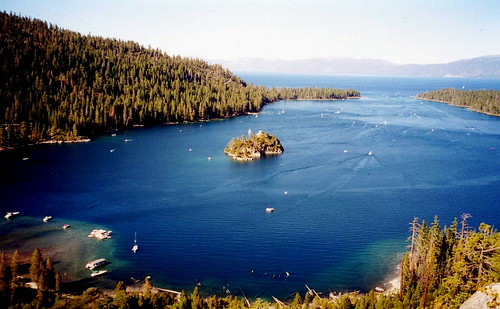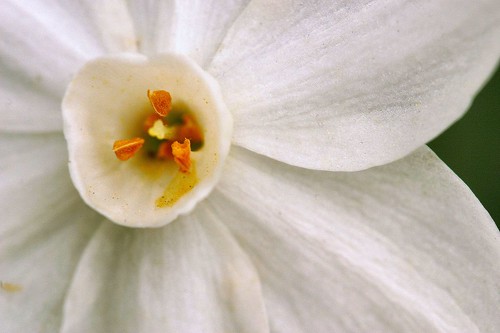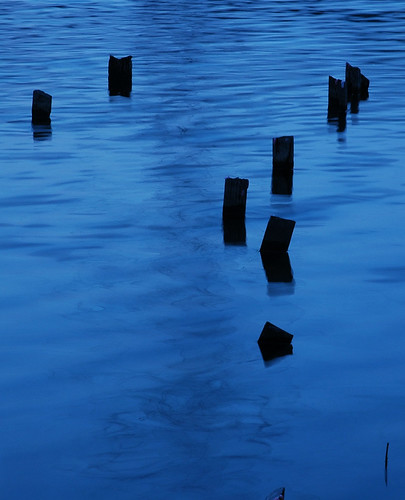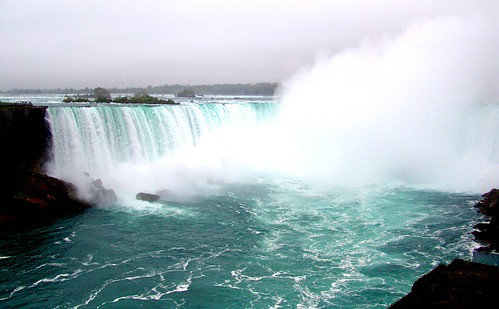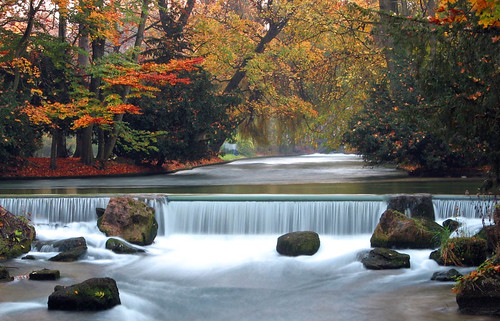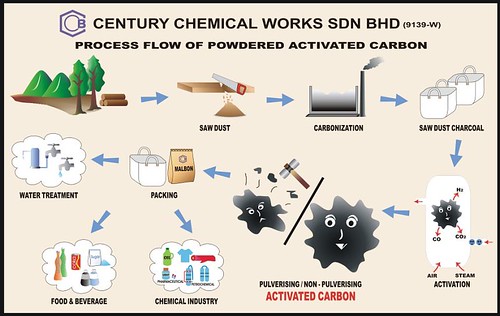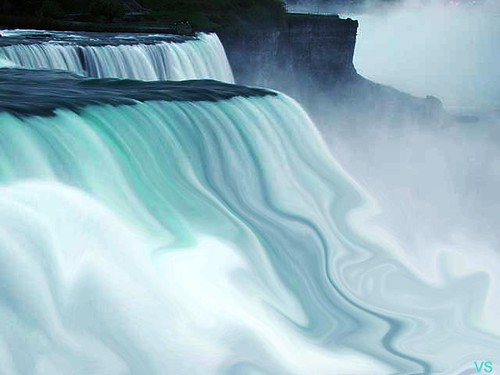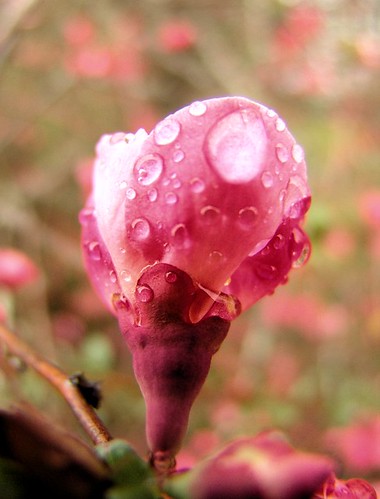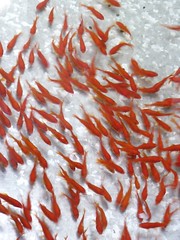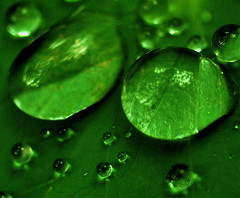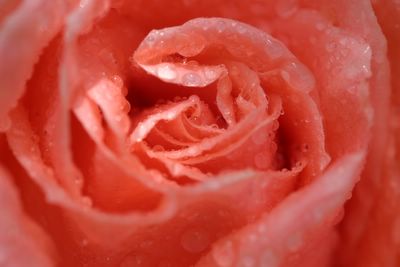In 2002, I have spend some 2 visit to Hoover Dam in Nevada.
I am told that most of the water in Southern California are supplied by Colorado river & Hoover Dam.
The water level in the dam is lower each year. These create a serious concern about the ever increasin drinking water price in Southern California.
Well, if we are not taking step to preserve the water supply & plant more trees, we would be facing our own destructions for not having enough water supply!!
Monday, December 05, 2005
Hoover Dam
Friday, November 25, 2005
Water Pollutions
Looking at the beautiful views of this Lake Tahoe.
Clear blue water.... Very nice view...etc.
But you looking at the boat on the Lake!! When I was visiting Lake Tahoe some 3 years back, What I found is there is very fine layer of oil on top of it.
With the speed boat & gas base water transport on the Lake, sure it would not be long, we would not be able to enjoy these beautiful scene anymore.
But most import is also the drinking water pollutions & after maths of drinking these polluted water!!
That would be really sad!!
Wednesday, November 23, 2005
Green House Effects!!
This beautiful Narcissus suppose to be the flower's of spring.
However, it is blosom in my yards since late Oct 2005.
This is really a concern to all. The pollutions that cause the Green House effects is altering the Biological clock of the plants'.
Pollutions on the air when after raining , those particles would polluted our drinking water on earth.
These is a seriouse concern to all.
We need to responsible & take action now, before it is too late!!
Sunday, November 20, 2005
Blue Water
When the sky is clear & blue, the lake or reservoir water must be clear & Blue!!
If it is not then, there is a serious pollution issues that you have to take action.
Water is 75% of our body.
We need to treasure clean water!!
Sunday, November 13, 2005
Cleaningness of Water
Looking at the water falls quality.
You see the nice green & blue.
But when I was last at the Nigara Falls, I found lots of oil stain floating on it surface.
We have to be concern on the water quality on earth, to all what we can to protect it & ensure that the water that we during, for growing of plants & vegetables & clean.
So that we can enjoy our longevity & great health!!
Monday, October 31, 2005
Global Warming!!
Looking at this photos, I am sure the plants' are confuse with the wealther conditions now.
i.e. The satellite forecast is day teperature is 70 degree F, but it went up to 78degree, night temperature is 58 dagree, then it went down to 52 degree!!
Click on the photos to read more...
If we are not protecting our environment & water & air. We would be responsible for our own doing!!
Sunday, October 30, 2005
Clean Water
We need to consistently check our environment.
Cut less trees, plant more trees & green our landscape.
Otherwise, the beauty of our mother nature would be gone.
We would no longer be able to enjoy the scenary like these!!
Sunday, August 21, 2005
Powder Activated Carbon for Water Filtration
I found this poster on www.flickr.com.
It is a knowledge for you to know how the filtration processs work.
Sunday, August 14, 2005
Water Viaduct That is Century Old
Monday, May 16, 2005
West Palm To Study New Ways To Treat Water
It is important constantly to seek new ways & R & D on the subject matter, one cannot wait until the problem's surface then start to find a solutions to it. That would be too late.. lost a life's & money would happen.
West Palm to study new ways to treat water
By Thomas R. Collins
Palm Beach Post Staff Writer
Monday, May 16, 2005
WEST PALM BEACH — City residents turned on their faucets one Monday morning last month only to be slapped in the nose by foul-smelling water that tasted like dirt.
City utility officials say they're about to take a hard look at their water system to keep the wincing to a minimum when people pick up their glasses.
More local news
Latest breaking news, photos and all of today's Post stories.
• Sound off in the forum
• State/Legislature
• Columnists
• Crime, live scanners
• Photos
• Special reports
• Weather
• Traffic
• Obituaries
They'll have a lot to review.
Among the 40 largest cities in Florida in terms of population, West Palm Beach is one of only three that rely primarily on surface water — a source that most in the water industry agree is harder to treat and is subject to algae blooms, like the one that had bottled-water sales skyrocketing recently.
When the weather turns dry, the city turns to Lake Okeechobee, which is so polluted and unfit for providing drinking water that it is frequently described as "chocolate milk" full of phosphates and nitrogens that allow algae to flourish and release foul-tasting compounds. And it's getting worse all the time, making future algae blooms more likely.
Despite that, the city has not turned to more sophisticated ways of treating water that could remove the offensive stuff. At least 17 of the cities in the top 40 have done so, including the other two that rely on surface water: Tampa and Melbourne.
The city's study comes in the middle of a population explosion in which 15,000 more water drinkers have moved into West Palm Beach over the last four years.
Water experts say the promise of more frequent algae blooms is a problem West Palm Beach shouldn't ignore.
"Sometimes you encounter a situation beyond what you expected to have," said Michael Hambor, an operations supervisor with the Palm Beach County Health Department who oversees drinking-water quality. "Now they're going to have to go back and decide what do we do when these things happen."
"I think they have a lot of opportunities with their water treatment facility," said Randy Smith, spokesman for the South Florida Water Management District.
City utility officials promise to respond.
"If they have some alternative methods that would really help our customers, we will definitely budget them and build them," Public Utilities Director Ken Rearden said. "I don't want to deal with this every year."
Ever since railroad tycoon Henry Flagler started drawing rainwater from a low-lying area for his Royal Poinciana Hotel in 1894, the city has relied on surface water.
Today, 19 square miles of wetlands west of Florida's Turnpike store rainwater for drinking. The quality of that water is superior to other surface sources, such as the Hillsborough River, which Tampa uses.
The city is trying to decrease its reliance on Lake Okeechobee during dry periods. It has tested a program in which water is stored in underground wells, though an expansion of that system has stalled because of electricity problems.
The city also is planning to open a plant that treats waste water and returns it to the drinking water supply, but that has been delayed because of problems with the contractor, utility officials said.
"Our mission is to stop reliance on Lake Okeechobee because of the water quality," Rearden said.
The city's plant has won awards and West Palm Beach once won an award for best-tasting water in the region, though that was so many years ago few can remember when it was.
Still, a recent algae bloom, prompted by a hurricane-churned Lake Okeechobee, threw the city for a loop. Utility officials, who use powdered carbon to treat the compounds, simply added more. But they were adding it to the wrong place at first, and had to fix it. They eventually received emergency permission to tap into an underground well of cleaner water to dilute the city's water. Since then, they've upped the amount of chlorine in the water for better disinfection.
Palm Beach County objected to the city's use of the well, worrying it might hurt the quality of the county's water sources nearby.
The city has painted itself into a corner on the algae problem, said Bevin Beaudet, the county's utilities director and past president of the American Water Works Association.
"They're not really looking for a longer-term solution," he said. "It would be presumptuous to say I know how to solve their problems. But if they worked on it they could do that."
More and more cities are turning to methods of treating water that are more sophisticated than West Palm Beach's chemical-treatment method. One is the use of synthetic membranes through which water passes.
Others use ozone, which mixes with the water and changes the molecular makeup of the impure material to render it odorless and tasteless.
The county began using membrane and ozone treatment in the 1990s, in part to eliminate taste and odor problems caused by sulfur, a common problem with underground water.
"The studies showed that the ozone greatly improved the taste and odor of the water and also helped us meet the future regulations," Beaudet said. Moving to ozone also would eliminate the need for chlorine and the waste product associated with it, he noted. Boca Raton and Boynton Beach have turned to membranes.
Rearden said the city will consider all methods, but said going to ozone would be expensive.
"Can you think about what the water rates would be for that?" he said.
Beaudet said the county's rates rose 10 percent or 15 percent over five years when the upgrades were made.
The Orlando Utilities Commission raised rates 10 percent for four straight years in the late 1990s to pay for its switch to ozone.
Others in the industry said newer isn't necessarily better.
WestPalmBeachPost
Friday, May 06, 2005
Character of Water
The Character of Water Are
As Serene as the Widow Tree
As Smooth as the skill
As Power as the Avalonche Force
With these characters then it is affecting our health......
Tuesday, April 26, 2005
Thursday, April 14, 2005
Water for Great Health of Live
Like The PLant's..Flower's...Animal's..
We Human too.. Need Clean Water..
Free From Pollutions
Free From Contaminations
For The Great Health of Us, All Life On The Mother Earth.
Do a little each
Second
Minute
Hour
Each Day &
Everyday...
To Protect our Environment & for Our Great Health!!
Tuesday, April 12, 2005
Clean Water To Bring Back Life
There are always difference types of tropical fishs in the ponds.
Then after when the area become more populated. 1st it was the snakes.. then the fsih is allgone within half a year.
You see the industrailizations have kills life's.
We Baby bloomers' would have to clean these up for our love ones!!
Green The World.
Monday, April 11, 2005
Tulips With Rainbow Color
Before Industrialization is Nature Green & Colorful.
Like Our Body, The Mother Earth is Containing 75% of Water.
Today, Our Enironment are polluted, Water Contaminated, Once Our Water Resource Dry Out.
Imaging these beatiful scene can only see in Our Digital Archives.
It Would Be A sad Future for Our Heirs.
Do Something Now to Protect Our Mother Earth!!
Clean Water Need More Green
Is Clean & Clear!!
More Trees Have Been Cut, Mean More Pollutions;
Less Oxygen!!
We need More Trees & Green Plants To Do The Organic Filtering;
Also, More Oxygen Means More Water!!
Better Health for US All!!
Saturday, April 09, 2005
Friday, April 08, 2005
Keeping the Peace: Spill Capture at Niagara Falls
Then It was the first time in my life that I see myself the historical landmark of nature. I did took a trip to the horseshoe fall. The views are spectacular.
I also have a close look of the cleaningness of the water ther. My impression is that the water is contaminated as I see the water is no blue or green , it is grey!!
I can understand the reason why it is grey!! As the tour barges are propelled by diesel. Overtime, there are leakage from the barges to the falls. These not only happen in Niagara Falls, it also happen in Lake Tahoe, when I last visit in 2002.
Eventhough the case study is done & spill are quickly clean of, the complete evaluations must be done & objectives must be agree to clean up the pollutions of the Niagara Fall.
Case Study: Keeping the Peace: Spill Capture at Niagara Falls
4/6/2005
The Peace Bridge Authority of Buffalo, New York and Fort Erie, Ontario completed re-construction of a Canadian truck processing yard at this busy international border crossing. The new construction called for a storm water management system to prevent environmental damage from commercial motor vehicle leaks and spills that frequently occur in such a high traffic area.
This area has a particularly fragile ecological system which include the famous Niagara Falls tourist and recreation area. Fortunately, the re-construction engineering plans specified two Stormceptor units.
On August 19, 1997, a tanker truck transiting the border was sent into Canada Customs for secondary inspection. The area for inspection is a congested holding lot in constant use. The truck suddenly developed a tank leak while in the lot. The leak was quickly cut off, but not before 400 gallons of palm oil spilled into the storm sewer system.
The two Stormceptor units trapped the oil and completely contained the spill, keeping it out of the eco-system. The storm water management system included sluice gates as a secondary containment, but the Stormceptor units fully handled the situation, and the sluice gates were not employed.
The construction superintended for the Peace Bridge Authority reported, "The spill was quickly cleaned up, including the maintenance of the two Stormceptor units (via vacuum truck).
To say the least, we are pleased at the ease of clean up and quick return to normal operation, with no damage to the environment.
Water Online News for wastewater professionals
Saturday, April 02, 2005
Google Gulp -- SERO TONIC WATER
Think refreshing!!!!!.

Have Got into Business of Water for Great Health??
This is their Label

Here is how it look like.
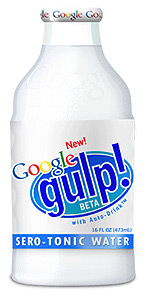
Sero-Tonic Water – Just try to stay down once your synapses get a blast of this bubbly concoction whose refreshing blend of selective serotonin reuptake inhibitors is perfect for those moments when all your other beverage options just seem soooo depressing.
Friday, April 01, 2005
Ships No Longer Allowed to Dump Ballast -- My Recommendation; Use Alternative Energy
However, the Marines life mirgrations more then often is not what one can control. As the marine life may have caught into the shell or those structure of their ship body.
The roots of the pollution on the sea mainly due to the diesel spills or leads. I my opinion, We must take the lead to go for the clean energy on all ship within the next 5-15 years. I have been researching into these issues since I was 20th years old.. each time the ship called into dock or the port, I saw the amount of waste & those pollutions or containminations.. such as human waste, scales, paints, rusts...etc., have been dump into the sea, be it intensionally or un-intentionally.
The only way out is to convert the ship engine to the Alternative Energy. Such as Hydrogen; Solar; Wind; even Fuel Cells should be considered.
Ships No Longer Allowed to Dump Ballast
By TERENCE CHEA Associated Press Writer
SAN FRANCISCO A federal judge ruled Thursday the government can no longer allow ships to dump without a permit any ballast water containing nonnative species that could harm local ecosystems.
U.S. District Judge Susan Illston ordered the Environmental Protection Agency to immediately repeal regulations exempting ship operators from having to obtain such permits.
"This is a slam dunk for healthy oceans," said Sarah Newkirk, clean water advocate for the Washington, D.C.-based Ocean Conservancy. "The court decision will prevent a vast amount of pollutants from the shipping industry from entering U.S. waters."
EPA officials did not immediately return calls seeking comment.
In 1999, the Ocean Conservancy and four other environmental groups petitioned the EPA to repeal the ballast-water exemption. They claimed the Clean Water Act prohibits the discharge of pollutants, including biological materials - such as invasive species - into U.S. waters without a permit.
When the EPA denied the petition, the conservation groups filed a lawsuit in federal court in San Francisco in 2003.
Invasive species are known to cause significant economic and environmental damage. Marine species such as mollusks often are inadvertently transported in the ballast water of ships and discharged at ports far from their origins.
The bay's two most destructive species that originated in ballast water are Chinese mitten crabs, which clog irrigation and drinking water pipes, and Asian clams, which consume large amounts of plankton at the expense of other marine species.
Invasive species in San Francisco Bay cause more than $40 million in economic damage each year, Newkirk said.
Printer Friendly Version
Wednesday, March 30, 2005
All Dried Up: How Clean Water is Threatened by Budget Cuts
I have posted an article on the Clean Water Budget cut issue some few weeks back.
According to the Sierra Club:

The Cut of $500million, or 37% of funding would affect the Water Quality information & effects of Jobs.
My additonal comment is that the Health issues that our people in this country would be at a very significant Risk!!
The following is the link to the PDF version of the Full report
All Dried Up
All Dried Up: How Clean Water is Threatened by Budget Cuts
A large coalition of state and local governments, labor, construction, public health and environmental groups released a new study highlighting the effects of cuts in clean water funding the Bush administration has proposed.
Overall, the Bush administration recommended a cut of $500 million, or 37 percent, in funding to help communities construct sewage treatment systems.
"All Dried Up: How Clean Water is Threatened by Budget Cuts" provides state-specific information on the effects of these cuts, water quality information, and effects on jobs.
Clean Water - Sierra Club
Sunday, March 27, 2005
Rain brings water to reservoir
Now looking at the United State here, the Green house effects have bought lots of snow & rain both in the East & the West of America.
Thailand have been having water drought very often. Although Thailand have been fronting sea but the inner country counties are of mountain terrain.
The water is importants to Thai farmer's as well , they depend on the water to produce the Rice to feed most of the Asia people. Even in USA & Cananda, the Asian be it Vietnamese, Thais, Singapore, Malaysian.. Hong Kong..Indonesian , they all like the Thai Jasmin rice.
So the water issue is not only the concern of the Thai people is the concern of the people of these connected world.
Rain brings water to reservoir
PRASIT TANGPRASERT
Nakhon Ratchasima _ Artificial rain has increased the water level in Lam Takhong reservoir in Sikhiu district by 300,000 cubic metres, but several areas in the province are still in dire need of water for both home and agricultural use.
Recent cloud-seeding operations bore fruit in the Northeast, particularly Nakhon Ratchasima, where artificial rain covered several target areas and increased the water level in Lam Takhong, a major reservoir in the province.
Nakhon Ratchasima governor Pongpayom Vasaphut said this year's drought was severe, with over 200 villages in 26 districts and six sub-districts being affected. More than 350 million litres of water had already been distributed to drought-hit areas.
Justice Minister Suwat Liptapanlop, Second Army Region commander Lt-Gen Hern Wanprasert and Mr Pongpayom yesterday jointly presided over a ceremony to release 40 water trucks each carrying 10,000-20,000 litres of water to most affected villages in Kham Thale So, Non Thai, Chakkarat, Non Sung and Chakkarat districts.
Mr Suwat said he would push the cabinet tomorrow to speed up disbursement of a 600-million-baht budget for the Department of Agricultural Extension to alleviate the hardship of affected farmers.
Mr Pongpayom said about 30-35% of agricultural areas in the province had been damaged by the drought. He has sought 607 million baht from the Agriculture Ministry to pay compensation to affected farmers.
So far 87 million baht of the governor's budget and another 124 million baht of the provincial administration organisation's budget have been spent to ease water shortage in the province.
The Second Army Region has set up 11 relief centres to distribute water.
Bangkok Post Monday 28 March 2005 - Rain brings water to reservoir
Friday, March 25, 2005
Facts About Water for The U.S. Population
Groundwater overdraft is 25% higher than its natural replenishment (Pimentel et al., 2004a).
A 1 pound loaf of bread requires about 250 gallons of water to produce the grains for the loaf.
Agriculture is the largest consumer of water in the nation, consuming approximately
Waterborne infections account for approximately 940,000 infections and approximately 900 deaths each year (Seager, 1995).
So imagine, 1 pond of bread requires 250 Gallons of Water to produce the grains of the loaf, then the water requires raise a chicken before it can be serve on the table would be at least 50 times.
I am sure you can envisage the seriousness of the the Water shortage for the Nation & also globally.
So, please save Water for Our Great Health.
Water Resources —
Fresh water is vital to maintaining all life, including crop and livestock production. The average amount of water pumped per American for personal, irrigation, and industrial use is approximately 1.7 million liters (500,000 gallons) per year.
Agriculture is the largest consumer of water in the nation, consuming approximately 80% of total pumped fresh water (Pimentel et al., 2004a).
A corn crop that produces about 9,000 kg/ha (140 bushels/acre) requires about 9 million liters/ha (1 million gallons/acre) of water. A 1 pound loaf of bread requires about 250 gallons of water to produce the grains for the loaf.
The rapid increase in water use in the U.S. is stressing both surface and groundwater resources. Currently, groundwater overdraft is 25% higher than its natural replenishment (Pimentel et al., 2004a). For example, in some regions of Arizona, water from aquifers is being pumped 10 times faster than it is being replenished (Pimentel et al., 2004a).
Associated with both surface and groundwater supplies is pollution, which causes serious public health problems.
Waterborne infections account for approximately 940,000 infections and approximately 900 deaths each year (Seager, 1995).
Nearly 40% of treated drinking water supply in the U.S. is contaminated with dangerous microorganisms (Platt, 1996).
Waterborne disease outbreaks in the U.S. are caused by microbial pollution, like E. coli, characterized by severe diarrhea and occasionally death. In addition, some ground and stream water is more than 90% polluted with significant quantities of harmful chemicals from agriculture and industry.
Approximately 80,000 different chemicals are used in the U.S. and many adversely affect human health as well as plants, animals, and microbes.
Land, Water and Energy Versus The Ideal U.S. Population
Wednesday, March 23, 2005
Rainbow looks at whether it could tap groundwater
However, the question is that the study on the ground water quality as well as the transportation water; then back from Southern California after filtration , the pipeline quality issues need to be look at thoroughly.
As my research found that the Pipeline with over 50 years of deposit; it can bring back the contaminations & pollutions after the filtration from Temecula.
Therfore, I hope that these issues would be addressed for the Great Health of the people.
Rainbow looks at whether it could tap groundwater
By: LORELL FLEMING - Staff Writer
FALLBROOK ---- It started out as something of a pipe dream: the idea of tapping into water collected in the Rainbow Valley Basin as a safe, reliable and locally controlled source of water.
Now, the Rainbow Municipal Water District may be inching closer to making that dream a reality and reducing the district's dependency on imported water, which makes up 100 percent of the current supply.
Armed with a $200,000 state grant and $100,000 of its own money, the district has studied rainfall totals and other data in the basin and is starting to develop a groundwater-management plan.
The initial study showed the district could extract between 1,000 and 3,000 acre-feet of water from the basin each year ---- enough to address the needs of the nearly 2,000 Rainbow district customers, said engineer Chris Trees.
Trees works for Encinitas-based Dudek & Associates, an engineering firm that contracts regularly with the district and was hired to complete the basin study. About $90,000 of the grant money has been spent so far, Trees said.
Dudek staffers are expected to finish the first draft of the groundwater plan in early April, according to Derek Reed, the Dudek engineer overseeing the project. Once the draft is complete, there will be a 30-day period for public review, as well as public workshops to discuss the plan. The district held a workshop Thursday to discuss initial findings of the study.
The Rainbow district uses about 30,000 acre-feet of water to meet the needs of its 7,100 customers in the rural pockets of North San Diego County: Fallbrook, Bonsall, Rainbow and parts of Vista.
An acre-foot is a measurement of water that is equivalent to about 326,000 gallons, about the amount of water that two families with four members would use in a year.
The next step would be to apply for another grant to do a field study, an analysis of samples from the basin's soil and groundwater, according to Reed.
Even if it is feasible to draw water from the basin, the project could take years, officials said. Public hearings must be held, environmental impacts must be studied and reports must be compiled.
Reed said it could be five to 10 years before the district draws water from the basin, which is east of Interstate 15 and west of Rainbow Mountain. The basin's southern border is Rainbow Valley Boulevard. Its northern border is where Rainbow Valley Boulevard curves to meet Old Highway 395.
Idea takes root
One of the people who pushed the Rainbow district three years ago to pursue a grant for a groundwater study was the district's former Division 5 director, Paul Christensen, Trees said.
Efforts to reach Christensen about the groundwater study that is under way were unsuccessful Thursday.
But the grant paved the way for what could be the district's first step in cutting some of its dependency on outside water agencies.
And officials such as the district's general manager, Greg Ensminger, said that finding a local source that could provide up to 10 percent of the district's water would be a coup.
"Anytime we can move away from being solely dependent on one source, that's a good thing," Ensminger said.
Water views
Division 4 Director Russ Hatfield said he is reserving judgment on the idea until he sees whether getting water from the aquifer beneath the basin, treating it, and providing it to customers would be a financial asset or liability for the district.
"What do you do after you get the water out of there?" Hatfield said. "Do you build a treatment facility to treat the water? Where is the money coming from? It could be a huge capital venture. We're using a lot of our money on infrastructure (improvements, repairs and maintenance)."
Rainbow water board President Bill Bopf, Division 3 director, said he would like to move forward with the groundwater study to get those questions answered.
"We should go through with the next phase. Get a grant, do the field study and see if this is possible," Bopf said in an interview last week. "It would be good to reduce our dependency on imported water."
Rua Petty, a Rainbow resident and vice president of his community's planning group, said that using the basin to serve Rainbow customers is an idea that might be worth exploring further.
"It might be worthwhile if it's economically viable and the science works out," Petty said during a public workshop Thursday about the groundwater study. He also said he would like to see it determined who legally has rights to the groundwater.
"It's a huge, kind of unknown, variable," Petty added.
Division 2 Director Jack Griffiths said he agrees that water rights need to be determined.
"That reinforces my fear of putting more money into this without having the legalities settled," Griffiths said during the workshop.
Water flows
All of the water that comes to the Rainbow district is imported. Rainbow gets its supply from the San Diego County Water District, which gets its supply from the Metropolitan Water District. The Colorado River and the state water project in Northern California are the sources of the Metropolitan district, which gets about 4.4 million acre-feet of water annually to distribute to local water districts and agencies, according to Metropolitan spokesman Bob Muir.
Once coming from Metropolitan's sources, the water for Rainbow goes to Lake Skinner near Temecula for treatment, then to the county water authority.
Muir said Metropolitan's board supports local districts' efforts to diversify water sources.
"That increases the pool of water available for Southern California," Muir added.
Contact staff writer Lorell Fleming at (760) 731-5798 or lfleming@nctimes.com.
North County Times - North San Diego and Southwest Riverside County columnists
Tuesday, March 22, 2005
Monday, March 21, 2005
Membrane Bioreactors Technology To Turn Waste Water Into Pristine Water
The advanced treatment plant design marries typical biological processes and membrane technologies, special filters through which water is forced, removing nearly all particles and bacteria to produce nearly potable water.
"Think of it like a screen on the window. We design the membrane pour sizes, and in this case to target phosphorus," said Steve Jones, project engineer with Garver Engineers.
The technology is routinely used in the drinking water industry, mostly in coastal areas where there is limited drinking water, Jones said, and no municipality in Arkansas and Oklahoma uses the membrane technology.
Anyway, the tecnology that applied to treats Waste Water to Drinking Water must be safe & also have the "Green" or "Eco" consideration.
Always have the Water for Great Health of People in mind.
New Technology To Meet Water Standards
By Richard Dean Prudenti
The Morning News
SILOAM SPRINGS -- Clean, clear water flowing in Sager Creek through Siloam Springs could model cleanup efforts for Arkansas and Oklahoma waterways.
Advanced technology capable of turning wastewater effluent into pristine water is prompting Siloam Springs leaders to spend money to modify the wastewater treatment plant to meet Oklahoma's water quality standards.
The city must limit the phosphorus level of the water the treatment plant discharges into Sager Creek approximately 750 feet from the state line, as required by Arkansas and Oklahoma environmental agencies.
Sager Creek is a tributary of Flint Creek, which feeds the Illinois River in Oklahoma.
Oklahoma officials prefer a phosphorus level of 0.037 milligrams per liter of water but agreed to a compromise of 1 milligrams per liter after Arkansas officials argued technology could not achieve lower limits.
New technology known as membrane bioreactors beats the compromise limit and even gets lower than the Oklahoma standard, according to manufacturers Zeon, U.S. Filter, Kubota and Mitsubishi.
The advanced treatment plant design marries typical biological processes and membrane technologies, special filters through which water is forced, removing nearly all particles and bacteria to produce nearly potable water.
"Think of it like a screen on the window. We design the membrane pour sizes, and in this case to target phosphorus," said Steve Jones, project engineer with Garver Engineers.
The technology is routinely used in the drinking water industry, mostly in coastal areas where there is limited drinking water, Jones said, and no municipality in Arkansas and Oklahoma uses the membrane technology.
David Cameron, the city administrator, plans to recommend this technology during a Siloam Springs Board of Directors work session at 6:30 p.m. Tuesday in the City Administration Building at 400 N. Broadway.
Siloam Springs would be added to the list of more than 100 places in the country using the advanced technology, Jones said.
City board members first must agree to spend $3 million more than the expected $12 million needed to expand the treatment facility.
"We're not going to build a plant to barely squeak by," Cameron said. "We need assurance that we can get way below the (compromise level); otherwise, we're walking on egg shells everyday."
Several Northwest Arkansas cities have until 2009 to comply with the water quality mandate set by both states or face legal action.
Expansion in Siloam Springs must begin in early 2007 when the city will renew its wastewater permit, which currently does not require phosphorus reductions. The Arkansas Department of Environmental Quality will include a phosphorus limit in the 2007 permit and require the city to comply within three years, when Oklahoma environmental officials plan to test water quality and possibly pursue more stringent discharge limits.
"No city can feel confident that it can remain at 1 milligram per liter forever," said Miles Tolbert, Oklahoma secretary of environment. "I can see why Siloam Springs wants to do it," Tolbert added. "They can make this one investment and not have to go back in a few years to do another upgrade. What a wonderful thing not to have to worry about this again."
Cameron hopes the federal or state government will help financially with the upgrade.
"This technology is not normal and warrants attention on a federal level as well because this is an issue being dealt with all over the country," he said.
Garver Engineers of Fayetteville is willing to design the plant expansion and seek federal money.
The Arkansas Department of Environmental Quality might not be in a position to help fund the project, according to its director, Marcus Devine. However, he said, "I think their forethought -- thinking ahead of the curve -- is impressive."
Voluntary efforts to comply with ideal water standards through a new kind of treatment plant provides a model for both states dealing with the phosphorus issue.
"They have looked under every rock to see what technology's out there," said Ed Fite, administrator of the Oklahoma Scenic Rivers Commission, who helped the city select Garver Engineers.
"Siloam Springs realizes to sustain economic activity that's going on and quality of life they have to ... approach wastewater treatment needs on a proactive basis," Fite said.
Fite commended Fayetteville as well for spending $125 million on treatment facility upgrades to release phosphorus at the compromise limit.
"They are actually discharging less than that, getting close to the number we want," Fite said.
Oklahoma battled Fayetteville in the U.S. Supreme Court and won a 1992 ruling that upstream states can be required to meet the water quality standards of a downstream state.
Print Version
Friday, March 18, 2005
Climate Change Inevitable -- Is Our Duty To Reverse It!!
This is a alarming statement!! You see what is the use for us to cry over these?? For what is happening & about to happen is not just would be gone away by talking about it. Kyoto Accord!! is suppose to get all into actions. But these are far from getting countries to put act together.
In my opinion, reducing the Carbon dioxide is the key issue!! So looking at the actions to stop:
Coal Fire Power Plant
Fossil Fuel Power Plant
Hydroelectric Power Plant..etc.
The world must take seriously in:
Stop Cutting Trees
Planting Trees & Reforrestations Today.
So that we would have more Oxygen & clean water for our future generation.
Climate Change Inevitable
[Climate Change Inevitable]
Even if all greenhouse gases had been stabilized in the year 2000, we would still be committed to a warmer Earth and greater sea level rise in the present century, according to a new study by a team of climate modelers at the National Center for Atmospheric Research (NCAR). The findings are published in this week's issue of the journal Science.
The modeling study quantifies the relative rates of sea level rise and global temperature increase that we are already committed to in the 21st century. Even if no more greenhouse gases were added to the atmosphere, globally averaged surface air temperatures would rise about a half degree Celsius (one degree Fahrenheit) and global sea levels would rise another 11 centimeters (4 inches) from thermal expansion alone by 2100.
"Many people don’t realize we are committed right now to a significant amount of global warming and sea level rise because of the greenhouse gases we have already put into the atmosphere," says lead author Gerald Meehl. "Even if we stabilize greenhouse gas concentrations, the climate will continue to warm, and there will be proportionately even more sea level rise. The longer we wait, the more climate change we are committed to in the future."
The half-degree temperature rise is similar to that observed at the end of the 20th century, but the projected sea level rise is more than twice the 3-inch (5-centimeter) rise that occurred during the latter half of the previous century. These numbers do not take into account fresh water from melting ice sheets and glaciers, which could at least double the sea level rise caused by thermal expansion alone.
The North Atlantic thermohaline circulation, which currently warms Europe by transporting heat from the tropics, weakens in the models. Even so, Europe heats up with the rest of the planet because of the overwhelming effect of greenhouse gases.
Though temperature rise shows signs of leveling off 100 years after stabilization in the study, ocean waters continue to warm and expand, causing global sea level to rise unabated.
The paper concludes with a cogent statement by Meehl: "With the ongoing increase in concentrations of GHGs [greenhouse gases], every day we commit to more climate change in the future. When and how we stabilize concentrations will dictate, on the time scale of a century or so, how much more warming we will experience. But we are already committed to ongoing large sea level rise, even if concentrations of GHGs could be stabilized."
The inevitability of the climate changes described in the study is the result of thermal inertia, mainly from the oceans, and the long lifetime of carbon dioxide and other greenhouse gases in the atmosphere. Thermal inertia refers to the process by which water heats and cools more slowly than air because it is denser than air.
The new study is the first to quantify future committed climate change using "coupled" global three-dimensional climate models. Coupled models link major components of Earth's climate in ways that allow them to interact with each other. Meehl and his NCAR colleagues ran the same scenario a number of times and averaged the results to create ensemble simulations from each of two global climate models. Then they compared the results from each model.
The scientists also compared possible climate scenarios in the two models during the 21st century in which greenhouse gases continue to build in the atmosphere at low, moderate, or high rates. The worst-case scenario projects an average temperature rise of 3.5°C (6.3°F) and sea level rise from thermal expansion of 30 centimeters (12 inches) by 2100. All scenarios analyzed in the study will be assessed by international teams of scientists for the next report by the Intergovernmental Panel on Climate Change, due out in 2007.
The NCAR team used the Parallel Climate Model (PCM), developed by NCAR and the Department of Energy, and the new Community Climate System Model (Version 3). The CCSM3 was developed at NCAR with input from university and federal climate scientists around the country and principal funding from the National Science Foundation (NCAR’s primary sponsor) and the Department of Energy. The CCSM3 shows slightly higher temperature rise and sea level rise from thermal expansion and greater weakening of the thermohaline circulation in the North Atlantic. Otherwise, the results from the two models are similar. The models were run on supercomputers at NCAR and several DOE labs and on the Earth Simulator in Japan.
Thursday, March 17, 2005
How to prepare a planet for global warming
It is necessary to do something to stop these to prevent our heirs from the suffering.
In my opinions,
we need to stop the Lodging of Trees.
Plant more Trees.
Stop using fossil fuel for energy generations
Encourage people to eat fruits & vegetables instead of Animal meats. Such as Breef.
Restore of rivers & natural terrains
Build homes & buildings with energy saving technology.
..etc.
How to prepare a planet for global warming
Convinced the phenomenon is inevitable, some scientists now focus on coping with it.
By Peter N. Spotts | Staff writer of The Christian Science Monitor
Scientists have long warned that some level of global warming is a done deal - due in large part to heat-trapping greenhouse gases humans already have pumped skyward.
Now, however, researchers are fleshing out how much future warming and sea-level rise the world has triggered. The implicit message: "We can't stop this, so how do we live with it?" says Thomas Wigley, a climate researcher at the National Center for Atmospheric Research (NCAR) in Boulder, Colo.
One group, led by Gerald Meehl at NCAR, used two state-of-the-art climate models to explore what could happen if the world had held atmospheric concentrations of greenhouse gases steady since 2000.
The results: Even if the world had slammed on the brakes five years ago, global average temperatures would rise by about 1 degree Fahrenheit by the end of the 21st century. Sea levels would rise by another 4 inches over 20th-century increases, just from expansion of the warming water. Rising sea-levels would continue well beyond 2100, even without adding water from melting glaciers and ice sheets. The rise highlights the oceans' enormous capacity to absorb heat and its slow reaction to changes in atmospheric conditions.
The team ran each model several times with a range of "what if" concentrations, as well as observed concentrations, for comparison.
Temperatures eventually level out, Dr. Meehl says in reviewing his team's results. "But sea-level increases keep on going. The relentless nature of sea-level rise is pretty daunting."
Dr. Wigley took a slightly different approach with a simpler model. He ran simulations that capped emissions, as well as concentrations, at 2000 levels. And he ran his calculations out to the year 2400. If concentrations are held constant, warming could exceed 1.8 degrees F. by 2400. If annual emissions are held at 2000 levels, warming could range from nearly 4 degrees to roughly 11 degrees F. The outcome depends on how sensitive the climate truly is to changes in greenhouse gases.
Wigley also calculates rates of sea-level rise. These range from 4 inches per century when limiting greenhouse- gas concentrations, to nearly 10 inches if annual emissions are held at 2000 levels. In this case, melting glaciers and ice sheets are taken into account.
The two researchers add that far from holding steady, concentrations of greenhouse gases continue to rise. Thus, at best, the results point to the least change people can expect, they say.
Both studies were published in Friday's edition of the journal Science.
The idea that some level of global climate change from human activities is inevitable is not new. But the word has been slow to make its way into the broader debate.
"Many people don't realize we are committed right now to a significant amount of global warming and sea-level rise. The longer we wait, the more climate change we are committed to in the future," Meehl says.
These studies are part of a wider effort to build the basis for the Intergovernmental Panel on Climate Change's next set of reports, slated for release in 2007.
While the concept of climate-change commitment isn't new, these fresh results "tell us what's possible and what's realistic" and that for the immediate future, "prevention is not on the table," says Roger Pielke Jr., director of the Center for Science and Technology Policy Research at the University of Colorado at Boulder.
To Pielke and others, this means adaptation should be given a much higher priority that it's received to date. "There's a cultural bias in favor of prevention," he says. But any sound policy includes preparation as well, he adds. "We have the scientific and technological knowledge we need to improve adaptation" and apply that knowledge globally.
How to prepare a planet for global warming | csmonitor.com
Tuesday, March 15, 2005
Fla. lawmaker's toilet paper tax likely to tank
Perhaps the best way is examing the cause of these pollutions or contaminations, then apply penalty to those who committed to the offence.
Also impose a 1.5% Levy for water pollutions control fund.
Fla. lawmaker's toilet paper tax likely to tank
THE ASSOCIATED PRESS
March 12, 2005
TALLAHASSEE, Fla. - The Florida Legislature is flush with good ideas.
Sen. Al Lawson's latest involves a way to pay for wastewater treatment and help small towns and counties upgrade their sewer systems.
The Democrat from Tallahassee is proposing a 2-cent-per-roll tax on toilet paper.
"We've got 17 million people in this state and all of them can contribute to protecting our underground water supply," he said.
In a Republican-dominated Legislature that doesn't like new taxes, the idea could end up in the tank pretty quickly.
Senate President Tom Lee said he didn't think it would get too far, but didn't rule it out. "We'll be getting to the bottom of it real soon," he said.
Lawson's been enduring plenty of jokes - bathroom humor, you might say - but he says it's a serious issue. Even if the proposal passes the Legislature, it would need approval from Gov. Jeb Bush. The president's brother said if toilet paper is taxed, people might use less of it.
"That's not necessarily a good thing," he said.
Newsday.com: Fla. lawmaker's toilet paper tax likely to tank
Monday, March 14, 2005
BBC NEWS | Science/Nature | Himalayan glaciers 'melting fast'
There should be more immediate action to:
1. Plant more Trees worldwide
2. Reduce & EliminateThe Use of Fossil Fuels
3. Use More Solar, Wind or Fuel Cells Energy for offices, Homes & Industries
4. Cut down the number of Automobil
5. Encourage More Vege & fruits consumption.
6. Cut down on Meat & Poultry farmming.
7. Stop Cutting Trees worldwide.
Himalayan glaciers 'melting fast'
Melting glaciers in the Himalayas could lead to water shortages for hundreds of millions of people, the conservation group WWF has warned.
In a report, the WWF says India, China and Nepal could experience floods followed by droughts in coming decades.
The Himalayas contain the largest store of water outside the polar ice caps, and feed seven great Asian rivers.
The group says immediate action against climate change could slow the rate of melting, which is increasing annually.
"The rapid melting of Himalayan glaciers will first increase the volume of water in rivers, causing widespread flooding," said Jennifer Morgan, director of the WWF's Global Climate Change Programme.
"But in a few decades this situation will change and the water level in rivers will decline, meaning massive eco and environmental problems for people in western China, Nepal and northern India."
'Catastrophe'
The glaciers, which regulate the water supply to the Ganges, Indus, Brahmaputra, Mekong, Thanlwin, Yangtze and Yellow rivers, are believed to be retreating at a rate of about 10-15m (33-49ft) each year.
The world faces an economic and development catastrophe if the rate of global warming isn't reduced
Jennifer Morgan, WWF
Hundreds of millions of people throughout China and the Indian subcontinent - most of whom live far from the Himalayas - rely on water supplied from these rivers.
Many live on flood plains highly vulnerable to raised water levels.
And vast numbers of farmers rely on regular irrigation to grow their crops successfully.
The WWF said the potential for disaster in the region should serve to focus the minds of ministers of 20 leading industrialised nations gathering in London for two meetings on climate change.
"Ministers should realise now that the world faces an economic and development catastrophe if the rate of global warming isn't reduced," Ms Morgan said.
Temperatures rising
She added that a study commissioned for the WWF indicated that the temperature of the earth could rise by two degrees Celsius above pre-industrial levels in a little over 20 years.
Allowing global temperatures to rise that far would be "truly dangerous", Ms Morgan said.
Nepal, China and India are already showing signs of climate change, the WWF report says.
Nepal's annual average temperature has risen by 0.06 degrees Celsius, and three snow-fed rivers have shown signs of reduced flows.
Water level in China's Qinghai Plateau wetlands have affected lakes, rivers and swamps, while India's Gangotri glacier is receding by 23 metres each year.
BBC NEWS | Science/Nature | Himalayan glaciers 'melting fast'
Sunday, March 13, 2005
You can't Beat Soap and Water
But looking at today soap, there have many variance & additives in it. One must beware of the type of soap that they buy for their purpose..
My opinions is buying the natural soap is better than the fancy one.
You can't Beat Soap and Water
By John von Radowitz, PA Science Correspondent
For ridding hands of viruses, nothing beats old fashioned soap and water, scientists have discovered.
The biggest study yet comparing handwashing products found modern disinfectant cleansers were not good at tackling resistant viruses.
Soap and water worked better, because the infectious agents were simply removed from the skin and flushed down the drain.
Among the viruses susceptible to soap were those which caused the common cold, hepatitis A, acute gastroenteritis and polio.
The researchers, from the University of North Carolina at Chapel Hill, USA, recommended that ordinary soap should be used in hospitals as well as waterless hand rubs and wipes.
They wrote in the American Journal of Infection Control: “Although viruses are a less common cause of health care associated infections than are bacteria, in situations in which infection with viruses is likely.. the use of soap and water washes should be considered.”
Antimicrobial agents were most efficient for reducing bacteria on the hands. But alcohol-based products – widely used in hospitals because of their convenience – performed relatively poorly.
Alcohol rubs became significantly less effective after hands were contaminated and washed a number of times over. And waterless wipes only removed half the bacteria from the hands.
The study was the first to test the ability of 14 different hand hygiene agents to tackle both bacteria and viruses.
It was also the first to investigate the effect of cleaning hands for just 10 seconds – the average time spent by doctors, nurses and other healthcare workers.
Dr Emily Sickbert-Bennet, who co-led the research, said: “Previous studies have had people clean their hands for 30 seconds or so, but that’s not what health-care workers usually do in practice, and we wanted to test the products under realistic conditions.”
A total of 62 adults took part in the study, in which five tests were performed on each of the 14 agents.
Volunteers first cleaned their hands and were then contaminated with the harmless bacterium Serratia marcescens and the virus MS2 bacteriophage.
MS2 is also harmless to humans, but similar in design to other viruses which can cause illness, such as hepatitis A.
The researchers said the results suggested it would be wrong for hospitals and other institutions to rely solely on alcohol-based cleaning products.
“Given the trend of a reduced efficacy of alcohol-based handrubs with multiple episodes, it is prudent to recommend traditional hand hygiene with an antiseptic agent or a non-antimicrobial soap periodically throughout the day,” they wrote.
Poor hand hygiene is known to contribute to hospital acquired infections such as MRSA, which cause an estimated 5,000 deaths in Britain each year.
The Government’s “cleanyourhands” campaign introduced through the National Patient Safety Agency aims to improve hygiene standards in the NHS.
A key element of the campaign is the placing of handrubs at the foot of beds and other places where staff have patient contact.
International research suggests that improved hand hygiene could reduce hospital infection rates by between 10% and 50%.
A Department of Health spokesperson said: “We agree with this useful study stating that both hand washing and hand disinfection are important in preventing patients from becoming infected.
“As the study suggests, the use of alcohol-based handrubs helps to improve hand hygiene compliance at locations where sinks are not available. Hand rubs can be positioned allowing staff to decontaminate their hands at regular intervals before each episode of patient contact.”
Scotsman.com News - Latest News - You can't Beat Soap and Water
Thursday, March 10, 2005
Tuesday, March 08, 2005
Ice Mountain bottler negotiating to purchase water from Evart -- Spring Water!!
The above statement gives you the knowledge of what is Mountain Spring Water!!
Some few years back. Arrowhead Mountain Spring Water were sued by the Government for mis-used the "Spring Water" on their bottled water. They have later sold to Nestle.
Nestle is aimming to become the biggest Drinking Water supplier in the world. When I was at a conference last month, I am told that by 2010, Drinking Water business would become a Multi-Trilions dollars business even bigger then the Oil business today.
Anyway for your Great Health, you need to unserstand the Water that you drink!!
Ice Mountain bottler negotiating to purchase water from Evart
March 7, 2005, 8:15 PM EST
EVART, Mich. (AP) _ Nestle Waters North America Inc. is in talks with local officials to begin purchasing city water that would be trucked 40 miles to its Ice Mountain water-bottling plant in southern Mecosta County.
To make the offer more enticing, Nestle Waters said it's willing to build 14 acres of baseball and softball diamonds and a football practice field by next year. The Greenwich, Conn.-based company also would relocate at least 300 campsites at the Osceola County Fairgrounds to provide a natural buffer around Evart's water wells.
"I'm tickled. It's like Christmas," said Howard Hyde, superintendent of Evart Public Schools.
Nestle Waters wants a second source of water, partly because the wells that feed the bottling plant near Stanwood are restricted to a monthly pumping average of 250 gallons per minute, the result of a lawsuit filed by a grass-roots environmental group.
Michigan Citizens for Water Conservation's suit said high-capacity wells feeding the bottling plant were diminishing nearby wetlands and a stream. A judge ordered the wells turned off but the company won a reprieve from a higher court, and the case remains under appeal.
Evart, population 1,700, is in Osceola County about 85 miles north of Grand Rapids. Its economy is anchored by auto-parts suppliers and a dairy that ships milk to Meijer stores, which together account for about 1,000 jobs.
Unlike in Mecosta County, there is little opposition in Osceola County to selling Evart's water for distribution elsewhere. Community leaders hope there will be a big payoff down the road: a new Ice Mountain bottling plant bringing scores of new jobs.
"That's really the pot of gold at the end of the rainbow," City Manager Roger Elkins told The Grand Rapids Press for a story published Sunday.
Indeed, Nestle Waters spokeswoman Deb Muchmore said it could be the "start of a long-term relationship."
"We've been extremely well received in Evart," she said. "The Ice Mountain brand continues to grow. Additional water capacity is needed."
The company sells bottled "spring" water, which means it must prove the groundwater is connected to a spring that flows to the surface, according to federal labeling rules. There also are internal standards for taste and quality.
Three of Evart's seven wells are drawing spring water, Muchmore said. One such well would be dedicated for use by Ice Mountain.
The water would be piped to a nearby transfer station, then transported by truck to the Ice Mountain bottling plant.
Newsday.com: Ice Mountain bottler negotiating to purchase water from Evart
Monday, March 07, 2005
86 % Americans Want Fed Investment In Water Issues
It is important for the American to move in the united front, so that the water issues are all address accordingly. Be it the waste water treatments or The Drinking Water issues
Think about the Great Health for our people. The Water Issues and standard must be address & standard cannot be lower!!
Poll: Americans want Fed investment in water issues
ALEXANDRIA, VA — Eighty-six percent of Americans believe that clean, safe water is a national issue that demands federal investment, according to a new poll conducted jointly by Republican and Democratic polling firms, the Environment News Service (ENS) reported today.
The poll, undertaken jointly by the Luntz Research Companies and Penn, Schoen & Berland Associates, surveyed 900 adults, the news agency reported.
More than three-quarters of Americans polled, 77 percent, would rather the federal government invest in water infrastructure than increase spending on entitlement programs (12 percent), ENS reported.
According to the news report, the poll found that 91 percent of respondents agreed that ''if, as a country, we are willing to invest over $30 billion dollars a year on highways and more than $8 billion a year on our airways, we certainly should be willing to make the necessary investments in our nation's rivers, lakes and oceans."
"This is not simply an environmental issue. It is an issue that is very personal to voters because of the importance of clean and safe water to their daily lives," pollster Dr. Frank Luntz said in the article. "This is one of those areas where Americans demand that Washington take responsibility."
The Bush administration has proposed to cut clean water funding from the Environmental Protection Agency's (EPA) budget for fiscal year 2006 from $8.1 billion to $7.6 billion, ENS reported. To achieve those numbers, the budget proposes a cut of $360 million (from $1.09 billion to $730 million) to the agency's Clean Water State Revolving Fund (CWSRF) program.
News
Thursday, March 03, 2005
Plastic bottles pile up as mountains of waste
It would take 1,000 years to dissolve??
& the gasses release into the air would cause Air pollutions.
& the remain would contaminating the Ground.
Think about the Great Health of our future Generation..
We need to put the action together.
Plastic bottles pile up as mountains of waste
Americans' thirst for portable water is behind drop in recycling rate
By Miguel Llanos Reporter MSNBC
Updated: 1:30 p.m. ET March 2, 2005
The biggest growth in bottled beverages isn't beer or soft drinks or juices. It's tasteless, colorless and sugarless water. And while that can mean fewer cavities and slimmer waistlines, it irritates Patricia Franklin to no end.
The director of a nonprofit group that promotes recycling, she spends her workday thinking about the bottles, cans and other container waste that most Americans take for granted.
The boom in plastic water bottles has her especially frazzled because while the recycling rate is extremely low, the demand from recyclers is actually quite high.
Franklin, who runs the Container Recycling Institute, doesn't blame individuals as much as what she feels is a recycling system that hasn't kept up with consumption patterns — especially when it comes to water.
Bottled water is the single largest growth area among all beverages, that includes alcohol, juices and soft drinks. Per capita consumption has more than doubled over the last decade, from 10.5 gallons in 1993 to 22.6 in 2003, according to the Beverage Marketing Corporation.
The growth has been even more impressive in terms of water bottles sold: from 3.3 billion in 1997 to 15 billion in 2002.
But most bottled water is consumed away from home, usually at a park, in an office or even while driving — areas where there's usually no recycling.
"The opportunities for recycling outside the home are minimal," Franklin says, "and therein lies the problem."
Bottles by the numbers
Only about 12 percent of "custom" plastic bottles, a category dominated by water, were recycled in 2003, according to industry consultant R.W. Beck, Inc. That's 40 million bottles a day that went into the trash or became litter. In contrast, the recycling rate for plastic soft drink bottles is around 30 percent.
The low water bottle recycling rate also impacts the overall recycling rate of all plastic, or PET, products. That's fallen from 53 percent in 1994 to 19 percent in 2003.
Plastics should be recycled so that less petroleum — a finite commodity — is consumed, Franklin says.
"The environmental impacts are in the drilling of the oil," she adds, noting that burning fossil fuel also releases gases that many scientists tie to global warming.
A second reason for recycling, Franklin says, is the litter factor. While plastic water bottles are not a significant percentage of overall waste, the empties are certainly all around us visually.
Thirdly, she says, is the fact that the domestic plastics recycling industry faces a shortage because so much is being exported to China for recycling there. That shortage has also led to fears that some companies will go bankrupt.
"There is a means to reclaim these bottles and use them to make new bottles and other products at home," Franklin says, "but they (recyclers) simply can't get enough of the containers to do it."
Strategies
The Container Recycling Institute thinks a nationwide bottle deposit law would create the incentive to recycle, especially when it comes to plastic bottles, and ease the burden on taxpayers, who pay for cleaning up litter.
"A national bottle bill, or producer responsibility bill, could turn it around and shift the costs from government and taxpayers to producers and consumers," Franklin says.
States with deposit laws already recycle four out of five bottles, Franklin notes, thanks in part to an army of recyclers — from Boy Scout Troops to office cleaning crews — that turns one person's trash into their income.
Eleven states have bottle bills but they are a patchwork with no two alike, she adds, and only three states, California, Hawaii and Maine, include plastic water bottles in their laws.
A national law, she says, should cover new containers that didn't exist 20 years ago, e.g. plastic water bottles, and enforce a dime-per-bottle deposit "as it is in Michigan, where deposit containers are recovered at a rate of 95 percent."
But while deposit legislation has had varying degrees of bipartisan support in Congress over the years, it has never become law.
Franklin blames opposition from the beverage industry, saying its campaign contributions have given it "incredible political clout in Congress and actually in every state legislature in the country."
Beverage industry opposition
That opposition certainly exists, but the beverage industry says it just doesn't make sense to force a deposit law on consumers.
"This cost burden placed on businesses is also passed along to consumers — levying a 'hidden tax' on both," the American Beverage Association said in an issue statement on the topic.
Curbside recycling at homes and businesses, as well as educating consumers, are the best methods for dealing with container waste, the group adds.
Tom Kinnaman, an economics professor at Bucknell University in Lewisburg, Penn., believes that while recycling is expensive the debate needs to reflect what he calls the "happiness" value of seeing litter cleaned up.
Factor that in and a deposit law can make sense, says Kinnaman, whose research includes household recycling trends.
"It turns out recycling also provides utility," he says. "It benefits society because it provides happiness for people in excess of what it costs to provide the happiness."
High tech, low tech
A Colorado company called Biota says it might have a way around the deposit controversy: a biodegradable bottle. All of Biota's water bottles are made out of the biodegradable plastic, which comes from corn starch in a process developed by the seed company Cargill and Dow Chemical.
Biota says that while traditional plastic bottles can take 1,000 years to degrade in a landfill, its bottles can biodegrade within 80 days in a commercial composting operation.
Won't the bottles dissolve on store shelves? Biota says they'll only degrade if they've been emptied and placed in composting conditions — high heat and humidity as well as microorganisms to eat away.
Biota is just getting off the ground, selling to a few health food stores in California, Colorado and Nevada. But it plans to expand, and even sell via the Internet.
Franklin sees hope in the biodegradable plastic, but adds that a big, unanswered question is whether mixing those bottles with PET bottles might contaminate the latter in the recycling process, making them useless.
"The concern is if we are going to be able to transition to that type of plastic what will be some of the impacts on companies that are trying to recycle PET bottles out there," she says.
And what about a low-tech approach of just educating the public to assume more responsibility, taking those plastic bottles home to a recycling bin instead of leaving them in a trash bin at a park?
MSNBC - Plastic bottles pile up as mountains of waste
Tuesday, March 01, 2005
New York appeals court says new farm manure rules not protecting water
The farms, it added, can generate each year millions of tons of manure, which carries potentially harmful pollutants including pesticides, bacteria, viruses, trace elements of arsenic and compounds such as methane and ammonia.
When properly applied, manure can be spread on fields and serve as fertilizer. But improperly applied, the court said, it can pollute.
These not mentioned about the treatment to the manure & the waste water after treatment issues.. certainly these is manure issue must treat with care, otherwise the ground water on earth would be further polluted. thus for our Drink water.
For the Great Health of our people Drink Water Safety is the Number priority.
FARM SCENE: New York appeals court says new farm manure rules not protecting water
By LARRY NEUMEISTER Associated Press Writer
February 28, 2005, 9:51 PM EST
NEW YORK -- A federal appeals court on Monday agreed with environmentalists that new federal clean-water rules were not protecting the nation's waters from the manure pollution of large farms.
The 2nd U.S. Circuit Court of Appeals in Manhattan said it agreed with environmentalists who claimed in lawsuits that the rules failed to provide meaningful review of plans developed by the farms to limit the pollution.
The appeals court said the rules imposed in February 2003 by the Environmental Protection Agency were arbitrary and capricious and did "nothing to ensure" that each large farm was complying with requirements to control the pollution.
Its ruling requires the EPA to make changes so it can ensure compliance by the farms with the Clean Water Act, which includes "the ambitious goal" that water pollution be eliminated. It also said the agency must provide a process that "adequately involves the public" as it creates a new system.
Robert F. Kennedy Jr., president of the Waterkeeper Alliance, an international grass-roots organization connecting and empowering 129 local water protection programs, said he was grateful that the court had rebuked "the government and the barons of corporate agriculture."
"These regulations were the product of a conspiracy between a lawless industry and compliant public officials in cahoots to steal the public trust," Kennedy said in a release.
A telephone message for comment left with the EPA in Washington, D.C., was not immediately returned Monday.
The appeals court noted the average large farm raises 10,000 sheep, 55,000 turkeys or 125,000 chickens and the largest can raise millions of animals.
The farms, it added, can generate each year millions of tons of manure, which carries potentially harmful pollutants including pesticides, bacteria, viruses, trace elements of arsenic and compounds such as methane and ammonia.
When properly applied, manure can be spread on fields and serve as fertilizer. But improperly applied, the court said, it can pollute.
The appeals court rejected some claims by the environmentalists, including that the EPA failed to consider the best technologies to control pollution or that certain costs of pollution control can be demanded of farms because costs can be passed to consumers. It said the EPA had adequately explained that "farmers are at the bottom of a long food marketing chain, subject to imperfect market conditions."
It also noted that the EPA had done extensive data collection, visiting more than 116 large farms in more than 20 states, attending conferences, meeting with trade associations and accepting about 11,000 public comments on its new rules.
The EPA rules require large confinements _ defined as having at least 1,000 beef cattle and 2,500 swine _ to obtain water pollution permits every five years. Some medium ones _ with 300 beef cattle and 3,000 swine under 55 pounds _ may be required to get one. Different head count thresholds are set for livestock operations including sheep, chicken and turkeys.
Any farm required to have a permit also must have a plan spelling out how it will manage manure. Farmers are required to file annual reports summarizing their operations.
Forty-five states manage the program themselves while activities in Alaska, Idaho, New Hampshire, Massachusetts and New Mexico and in the District of Columbia are managed by the EPA.
Newsday.com: FARM SCENE: New York appeals court says new farm manure rules not protecting water
Sunday, February 27, 2005
Drinking Water Supplier Wins Bronze Medal
However, there is still far more room to improve & achieve 1st if possible.
The Drinking Water Standard cannot be lower or Maintence, it have to be upkeep forever.
Southland's Major Drinking Water Supplier Wins Bronze Medal at International Water Tasting Competition
LOS ANGELES--(BUSINESS WIRE)--Feb. 27, 2005--The drinking water that's coming soon to all Southern Californians received the third-place bronze medal Saturday at the International Water Tasting competition.
Metropolitan's prize-winning water was drawn at its Henry J. Mills Treatment Plant at Riverside, the first of MWD's five treatment plants that has been retrofitted with the ozonation method of water disinfection that produces better-tasting water.
"We're delighted to be recognized again for the outstanding quality of our water," said Metropolitan board Chairman Wes Bannister, "and also to have our first ozone treatment process receive this kind of validation."
Not that the water that 18 million Southland residents currently receive from Metropolitan's other plants is less-delectable. Samples taken at other locations in recent years have won first- and second-place medals at the annual tasting competition held in the historic spa town of Berkeley Springs, W. Va.
However, the characteristics of other local and imported waters, and the effects of local and household water pipes, may affect the taste and scent of homeowners' tapwater.
Metropolitan's water imported from Northern California and the Colorado River comprises about half the drinking water used in a 5,200-square-mile area covering portions of Los Angeles, Orange, San Diego, Riverside, San Bernardino and Ventura counties. Metropolitan's 26 member public water agencies use the imported water to supplement, or in place of, local water supplies -- mostly ground (well) water.
"The ozone disinfection process that we are using at the Mills plant will be on-line at our Jensen plant in Granada Hills this summer, and at our plants in La Verne, Yorba Linda and Murietta by December 2009," said Metropolitan interim CEO Gilbert Ivey. "Metropolitan's board has made a $750 million commitment to ozone retrofits at all of our plants in order to maintain the high quality of our drinking water."
A safe, colorless gas with a pleasant, fresh scent, ozone is a form of oxygen. It is bubbled through drinking water to destroy potentially harmful organisms and also to reduce unpleasant tastes and odors. Ozone, which has been used for disinfecting drinking water since the 1800s, is also noteworthy because it causes fewer potentially harmful byproducts than chlorine.
The water-tasting competition at Berkeley Springs is held annually on the weekend closest to the birthday of George Washington, who was one of Berkeley Springs' early real estate speculators and surveyors. The hot sulphur springs that Washington and his friends hoped would become a tourist attraction are still flowing.
Twenty-nine cities from the United States and several other countries sent entries to the contest, where water samples are judged in the same manner as wine tasting. Metropolitan's water competed against entries from Maryland, Ohio, Colorado, Florida, New Jersey, Wisconsin and New York and other states, as well as entries from Canada and New Zealand.
Carbonated and sparkling bottled waters, and water bottle packaging and design also have their own categories in the event.
In the Municipal Water category, Metropolitan took third place, tying with Rice Lake, Wis. Water from Town of Gibsons, BC, Canada, was judged best in the world; Daytona Beach, Fla., won best in the United States, and Putaruru, New Zealand, placed second.
Metropolitan's entry was selected by its Flavor Profile Panel, a group of employees at MWD's Water Quality Laboratory who are trained in wine-and-beverage-tasting methods. The FPP meets several times weekly -- sometimes daily -- to test water samples from throughout Metropolitan's aqueduct, treatment plants and pipelines.
Their objective is water lacking in noticeable tastes or scents -- the same characteristics that impressed the judges at Berkeley Springs.
The Metropolitan Water District of Southern California is a cooperative of 26 cities and water agencies serving 18 million people in six counties. The district imports water from the Colorado River and Northern California to supplement local supplies, and helps its members to develop increased water conservation, recycling, storage and other water-management programs.
Gmail - Google Alert - Water
Saturday, February 26, 2005
Dirty water, sanitation kill thousands daily-experts
So 4,000 Children died per day due to un-save drinking water is believed to be under stated!!
It need the authorities in respective countries to work hand in hand with WHO to enforce the safety water standard.
As well as the public awareness & education program.
Safe & Clean Drinking Water for Great Health for All.
Dirty water, sanitation kill thousands daily-experts
25 Feb 2005 00:01:00 GMT Source: Reuters
By Karin Strohecker
LONDON (Reuters) - Unsafe drinking water and poor sanitation kill 4,000 children every day, global health experts said on Friday.
They described the deaths as a "silent humanitarian crisis" and called for immediate action.
"There should be an outcry, from the health community above all, for immediate, concerted efforts to confront the reality that sanitation coverage rates in the developing world barely keep pace with population growth," said Dr Jamie Bartram, of the World Health Organisation (WHO).
Four out of 10 people around the globe do not have access to a simple pit latrine and one-fifth have no source of safe drinking water.
"Far more people endure the largely preventable effects of poor sanitation and water supply than are affected by war, terrorism and weapons of mass destruction," Bartram said in an article in The Lancet medical journal.
The report was published as part of a review of the Millennium Development Goals, a number of pledges set out in 1990 to improve living conditions in developing nations by 2015.
But the researchers said realising the goals of eradicating extreme poverty, creating primary school education and reducing child mortality would be difficult without solving the water problem.
Half of all hospital beds in the world are filled with people suffering from water-related diseases such as malaria, diarrhoea and trachoma, an eye disorder, according to the report.
Tackling the problem means addressing it from all sides.
Bartram pointed to the fragile balance between development and safety when creating reservoirs and irrigation schemes. Crop watering systems can improve nutrition but they also provide a fertile breeding ground for diseases.
"Improving irrigation to avoid standing or slow-moving water and improving disposal of household wastewater can reduce mosquito breeding and transmission of malaria," he said.
Reuters AlertNet - Dirty water, sanitation kill thousands daily-experts

